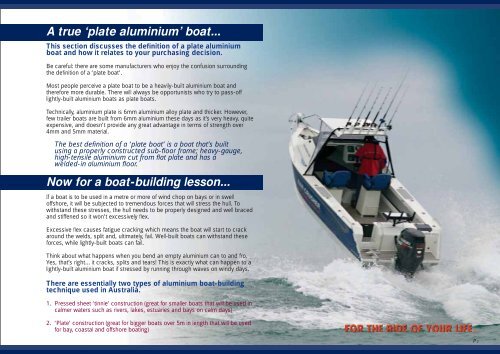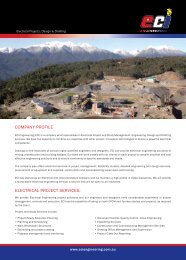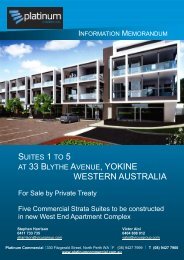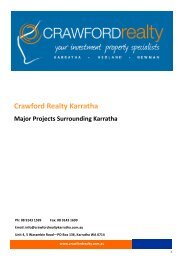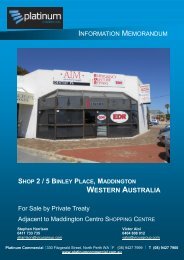high-performance plate aluminium fishing boats - Aussiehome
high-performance plate aluminium fishing boats - Aussiehome
high-performance plate aluminium fishing boats - Aussiehome
- No tags were found...
You also want an ePaper? Increase the reach of your titles
YUMPU automatically turns print PDFs into web optimized ePapers that Google loves.
A true ‘<strong>plate</strong> <strong>aluminium</strong>’ boat...<br />
This section discusses the denition of a <strong>plate</strong> <strong>aluminium</strong><br />
boat and how it relates to your purchasing decision.<br />
Be careful: there are some manufacturers who enjoy the confusion surrounding<br />
the defi nition of a ‘<strong>plate</strong> boat’.<br />
Most people perceive a <strong>plate</strong> boat to be a heavily-built <strong>aluminium</strong> boat and<br />
therefore more durable. There will always be opportunists who try to pass-off<br />
lightly-built <strong>aluminium</strong> <strong>boats</strong> as <strong>plate</strong> <strong>boats</strong>.<br />
Technically, <strong>aluminium</strong> <strong>plate</strong> is 6mm <strong>aluminium</strong> alloy <strong>plate</strong> and thicker. However,<br />
few trailer <strong>boats</strong> are built from 6mm <strong>aluminium</strong> these days as it’s very heavy, quite<br />
expensive, and doesn’t provide any great advantage in terms of strength over<br />
4mm and 5mm material.<br />
The best denition of a ‘<strong>plate</strong> boat’ is a boat that’s built<br />
using a properly constructed sub-oor frame; heavy-gauge,<br />
<strong>high</strong>-tensile <strong>aluminium</strong> cut from at <strong>plate</strong> and has a<br />
welded-in <strong>aluminium</strong> oor.<br />
Now for a boat-building lesson...<br />
If a boat is to be used in a metre or more of wind chop on bays or in swell<br />
offshore, it will be subjected to tremendous forces that will stress the hull. To<br />
withstand these stresses, the hull needs to be properly designed and well braced<br />
and stiffened so it won’t excessively fl ex.<br />
Excessive fl ex causes fatigue cracking which means the boat will start to crack<br />
around the welds, split and, ultimately, fail. Well-built <strong>boats</strong> can withstand these<br />
forces, while lightly-built <strong>boats</strong> can fail.<br />
Think about what happens when you bend an empty <strong>aluminium</strong> can to and fro.<br />
Yes, that’s right... it cracks, splits and tears! This is exactly what can happen to a<br />
lightly-built <strong>aluminium</strong> boat if stressed by running through waves on windy days.<br />
There are essentially two types of <strong>aluminium</strong> boat-building<br />
technique used in Australia.<br />
1. Pressed sheet ‘tinnie’ construction (great for smaller <strong>boats</strong> that will be used in<br />
calmer waters such as rivers, lakes, estuaries and bays on calm days)<br />
2. ‘Plate’ construction (great for bigger <strong>boats</strong> over 5m in length that will be used<br />
for bay, coastal and offshore boating) ®<br />
P 2


